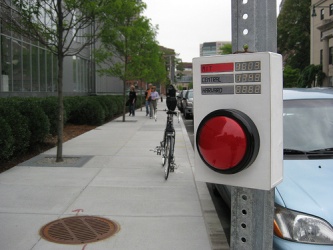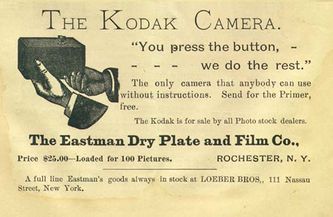User:Mathijs van Oosterhoudt/rwrm/button: Difference between revisions
No edit summary |
No edit summary |
||
| Line 77: | Line 77: | ||
== The history of the button. == | == The history of the button. == | ||
If we see the button as a means of controlling machinery, then there's an obvious precursor to the button, namely, the lever. A lever would be a very direct mechanical control of machinery, one where the movement of the lever is directly related to what it does, for | If we see the button as a means of controlling machinery, then there's an obvious precursor to the button, namely, the lever. A lever would be a very direct mechanical control of machinery, one where the movement of the lever is directly related to what it does, for example moving gears in place. Often machines would show it's working to the user, nothing was covered up, nothing was hidden, one could visibly notice how each element and each mechanical linkage influenced each other. One can anticipate what comes and come to a fully understand and decide whether to interact with the lever. | ||
When electricity became more commonplace in machinery, men needed an 'electronic lever' which would be able to influence the electrical circuit, simply by either closing it when open or opening it when closed (connected). The | When electricity became more commonplace in machinery, men needed an 'electronic lever' which would be able to influence the electrical circuit, simply by either closing it when open or opening it when closed (connected). The push button was a simply means of doing so. Compared to the lever the use is almost identical, a way to control machines, but in reality the push button does something very special that a lever does not: There is no direct correlation between the motion you are performing (That of pushing) to what the circuit might actually do for you. It's a very abstract way of control. This takes away our understanding and therefor there is no inherent understanding of what the button does. | ||
<div style="display: inline; width: 220px; float: right; margin-right: -100px;"> | |||
[[File:Ever_Ready_Flashlight_Ad_1899.jpg|333px]]</div> | |||
The theme of the ease of the button is one that | One of the very first push buttons produced for commercial use is that of the flashlight, which in itself is one of the simplest electrical circuits (A power source, a button and a light). The first electric flashlight was branded as the "Ever ready" flashlight. As one might imagine, it was a fair bit easier than torches, lanterns or candles. | ||
<div style="display: inline; width: 220px; float: right; margin-right: -100px;"> | |||
[[File:You_press_the_button,_we_do_the_rest_(Kodak).jpg|333px]] </div> | |||
The theme of the ease of the button is one that recurs often within it's evolution, perhaps most famously about 10 years later, when Kodak released the Kodak Brownie; a simple box camera, aimed at making photography accessible to everyone. It did this not only by making the camera very affordable for it's time, but most importantly, by making it easy. The camera would come pre-loaded with film, and once one had finished the roll, all you had to do was return the camera to Kodak, they would develop and print the photos, put a new film in your camera and send it all back (For a fee, of course). This whole process was summed up as follows; | |||
"You push the button, we do the rest." | "You push the button, we do the rest." | ||
Revision as of 10:18, 1 October 2014
The button.
Introduction.
[Steve: what makes the button interesting for you?] A button might seem like a very simple thing, but it's deceivingly complicated.
Personal motivation goes here.
This article will aim to dissect the physical push button and coin some simple terms to discuss proper and not-so-proper button design, based on real life user cases. While the focus lays on the physical button, the same information can be applied to digital (Computer, not the binary state which buttons often assume) button design as they tend to mimic their physical brethren. This article ignores the latter as there are no purely digital buttons, they are always paired to a physical one, most notably the computer mouse.
What is a button?
First of all, it's important to understand what a button is. A button is a physical object which offer a way of interaction to it's user, often part of a larger interface (Another wholly complicated and long subject). The form of interaction can be of endless ways, but in all cases the interaction is a means of achieving a goal. To get to that goal, however, we have to overcome certain obstacles. The stages of the button are as follows;
- Anticipation.
- Understanding.
- Interaction
- Feedback
- Goal.
These stages altogether can be passed in seconds, but all are present when one presses a button. When one encounters a button, but decides not to press, only the stages up to interaction are followed. -ADD MORE-
Anticipation.
The anticipation is the first stage to pressing a button. Anticipation is generally a state of joy at our encounter of a button. We speculate and ask ourselves questions about this button, questions as "How does it work?" or "What does it do?" and "Am I allowed to press it?". Unique to the interaction phase is that it is the only phase which in itself can be the goal of the interaction. A button can be pressed purely by the anticipation of pressing it, by the desire to understand it or to settle the questions in our head. Funnily enough, the button itself is rarely designed to purely satisfy anticipation. The physical appearance of a button can shape our anticipation enormously. It can either raise questions or answer them, the latter discussed in stage 2. The former can be by it's physical appearance ("Why does it look like it does?") or by it's context ("What is this button doing here?"). -ADD MORE-
Understanding
Understanding is the second stage of pressing a button. It is the user's attempt to settle the questions raised in the anticipation stage before actually making a conscious decision to press the button. The questions can be answered in a multitude of ways, whether it is the physical appearance of the button ("If it's locked behind glass, I probably shouldn't press it."), by the contextual location of the button ("It's on a door, so it most likely opens the door.") or by simply mimicking others and examining their results ("That user pressed the button and got a cookie, if I press the button I will also get a cookie"). -ADD MORE-
Interaction
Interaction is the third stage of pressing a button. This is where the user will have made his or her decision about what the button does, how it must be pressed, and whether to press it or not. It sets the inner mechanisms of the button in working, either by completing a circuit, breaking a circuit or triggering a chain of mechanical movements. -ADD MORE-
Feedback
Feedback is the fourth stage of pressing a button. It is one of the most important parts of the design of the button, as it is one of the few key moments where you can directly feed the user the correct and needed information that he or she desires. There are multiple forms of feedback:
Praising
The button praises the user for the interaction. It lets the user know through various methods that, yes, you did indeed press the button, and you did well doing so.
Criticizing
The button criticizes the user fo the interaction. It lets the user know through various methods that, yes, you did indeed press the button, but unlike praise, it was not a good idea to do so.
Neutral
The button does not give the user any feedback on whether it did the right thing, but does let the user know that it was indeed pressed.
None
The button does not let the user know whether it was a good or a bad thing that it was pressed, nor does it confirm that it was pressed. -ADD MORE-
Goal
The goal is the fifth and last stage of pressing a button. The goal rewards the user for pressing the button. -ADD WAY MORE-
The history of the button.
If we see the button as a means of controlling machinery, then there's an obvious precursor to the button, namely, the lever. A lever would be a very direct mechanical control of machinery, one where the movement of the lever is directly related to what it does, for example moving gears in place. Often machines would show it's working to the user, nothing was covered up, nothing was hidden, one could visibly notice how each element and each mechanical linkage influenced each other. One can anticipate what comes and come to a fully understand and decide whether to interact with the lever.
When electricity became more commonplace in machinery, men needed an 'electronic lever' which would be able to influence the electrical circuit, simply by either closing it when open or opening it when closed (connected). The push button was a simply means of doing so. Compared to the lever the use is almost identical, a way to control machines, but in reality the push button does something very special that a lever does not: There is no direct correlation between the motion you are performing (That of pushing) to what the circuit might actually do for you. It's a very abstract way of control. This takes away our understanding and therefor there is no inherent understanding of what the button does.
One of the very first push buttons produced for commercial use is that of the flashlight, which in itself is one of the simplest electrical circuits (A power source, a button and a light). The first electric flashlight was branded as the "Ever ready" flashlight. As one might imagine, it was a fair bit easier than torches, lanterns or candles.
The theme of the ease of the button is one that recurs often within it's evolution, perhaps most famously about 10 years later, when Kodak released the Kodak Brownie; a simple box camera, aimed at making photography accessible to everyone. It did this not only by making the camera very affordable for it's time, but most importantly, by making it easy. The camera would come pre-loaded with film, and once one had finished the roll, all you had to do was return the camera to Kodak, they would develop and print the photos, put a new film in your camera and send it all back (For a fee, of course). This whole process was summed up as follows;
"You push the button, we do the rest."
This popularized the concept of the button as something that makes complex actions simple.
THE button (The button in culture).
The button as a means of control.
-ADD MORE CHAPTERS.-


